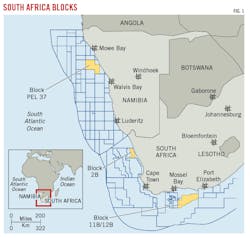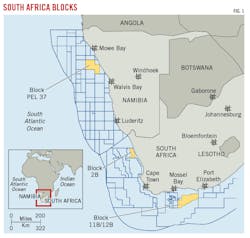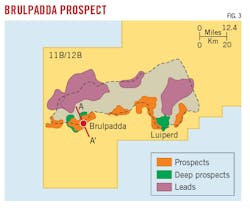South Africa oil and gas law could lead to further exploration in 2018-19
Tayvis Dunnahoe
Exploration Editor
With active exploration offshore South Africa later in 2018, the administration of newly elected President Cyril Ramaphosa's commitment to finalizing its oil and gas law could encourage more foreign investment. South Africa's newly-elected President Cyril Ramaphosa has moved swiftly to reshuffle his cabinet following his Feb. 15 inauguration. His appointment of Gwede Mantashe to Mineral Resource Minister is expected to accelerate passage of South Africa's Minerals and Petroleum Resources Development Act (MPRDA) Amendment bill. The bill has been before parliament for 5 years, and President Ramaphosa has called for its finalization.
South Africa's mining industry has languished. Heavy, often contentious, regulations govern exploration permits, mining authorizations, tax, royalties, and other industry related functions. Many of the country's laws have been mired in disputes and legal challenges that tend to deter, rather than attract, foreign investment.
Once the MPRDA Amendment bill is passed, the increased certainty in exploration and development programs should encourage more foreign investment.
Historical operations
The oil and gas industry drilled about 300 wells offshore South Africa from the late 1980s to the early 1990s. During apartheid and after transitioning to South Africa's current form of government, offshore oil and gas exploration had fewer incentives. Little activity occurred through the late 1990s until Pioneer Natural Resources began drilling in 2004.
Offshore activity has remained limited since mid-2014 in the wake of lower oil prices and political uncertainty in South Africa's resource development ministry. Lower operating costs and rising oil prices in the last year, however, have drawn some companies into the region.
With the potential for more certain oil and gas rules slated for late 2018 and several drill-ready prospects, South Africa's offshore region may reveal several world class discoveries.
Brulpadda prospect
Total SA recently sold 25% interest in exploration Block 11B/12B offshore South Africa to Qatar Petroleum (OGJ Online, Feb. 5, 2018). The transaction remains subject to regulatory approval, but the partnership on Block 11B/12B (Fig. 1) is preparing for the high-potential Brulpadda-1AX well scheduled to be drilled on the block at the end of 2018. Block 11B/12B covers 19,000 sq km in 200-1,800 m of water in the Outeniqua basin about 175 km offshore southern South Africa (Fig. 2).
Total attempted to drill Brulpadda-1AX in Winter 2014, but the well was suspended after harsh conditions exceeded rig specifications. Low riser angle restrictions, poor sea-state compensation systems, and insufficient power to dynamically position the rig forced the company to plug and abandon the well.
The Brulpadda-1AX re-entry is expected to commence in December and follows Total's extensive metocean study to monitor current, wind, and waves in the area to better understand conditions. The operator has contracted Odfjell Drilling Co.'s Deepsea Stavanger, a sixth-generation semisubmersible rig capable of drilling the Brulpadda well during the Cape summer.
Africa Energy Corp. CEO Garrett Soden described Block 11B/12B as a "unique exploration situation" where five amplitude supported closures all conform to structural closure. The Brulpadda well will test the first of these.
Predicted volumes are more than 500 MMbbl and the complex could exceed 2 billion bbl of prospective resources. Africa Energy owns 49% of Main Street, which holds a 10% stake in Block 11B/12B (subject to Government approval). Total maintains 45% operating interest with CNR International holding the remaining 20%.
The Brulpadda prospect is part of the Paddavissie turbidite play that covers more than 2,000 sq km and is a similar play to the much smaller Oryx and Sable complexes to the northwest in the adjacent Bredasdorp basin (Fig. 3). These complexes contain stratigraphically and structurally trapped oil and gas in reservoir quality channel sandstones that form feeders to the outboard Paddavissie fan systems. Source rocks in the fetch area comprise both mid-Aptian and Hauterivian shales that entered maturity in early Tertiary and are presently within the main stage of oil generation.
Africa Energy's current team has, with various employers, been exploring Africa continuously for the last 30 years. "The team is also very familiar with the Jubilee field in Ghana and the La Ceiba and Okume fields in Equatorial Guinea, all of which have some common elements to Block 11B/12B in South Africa and to Petroleum Exploration License (PEL) 37 Namibian geology [submarine fans]," Soden said.
The Brulpadda-1AX well is highly ranked in Total's global portfolio. Infrastructure is not a concern as there is existing oil and gas production next to Block 11B/12B. The Mossel Bay gas-to-liquids facility operates at a third of its capacity with a connecting pipeline about 70 km away. The Cape Town oil refinery is also nearby. Drilling techniques and procedures are tested and proven and South Africa's geological environments are well known. Brulpadda could be the start of a world class development offshore South Africa, much like Jubilee was for Ghana.
Block 2B
On South Africa's western coast, Africa Energy is advancing a farmout with plans to drill an exploration well in 2019 on offshore Block 2B (Fig. 1). The company was granted a 2-year renewal of its exploration license by South Africa's Petroleum Agency in February (OGJ Online, Feb. 27, 2018).
Block 2B covers 3,604 sq km in 50-200 m of water. The block contains the A-J1 oil discovery drilled by the former South Africa state-owned Soekor in 1988. The A-J1 well tested light oil from a Lower Cretaceous sandstone section. The A-J graben is a rift basin related to the Atlantic opening during the Early Cretaceous. In addition to the A-J southern graben, Block 2B also includes prospective acreage in the northern graben. According to Africa Energy, the greater rift trend in the region is like the East African Rift where major oil accumulations have recently been discovered in Kenya's South Lokichar basin and Uganda's Albert rift.
Soden told OGJ that six prospects have been identified on Block 2B, containing an estimated 400 million bbl of prospective resources. The southern and northern graben combined contain a total of more than 800 million bbl, most of which is in 150 m of water only 25 km offshore. The company plans to farm out 50% or more of the block on an estimated well cost of less than $20 million. "The 2019 drilling opportunity will occur 9-12 months after the farmout is complete," Soden said.
Africa Energy currently holds 90% participating and operating interests in Block 2B. Crown Energy AB holds the remaining 10% through a subsidiary company.
Namibia
Tullow Oil will drill on the Cormorant prospect in the Walvis basin offshore Namibia in September 2018. PEL 37 covers 17,295 sq km of the northern Namibian offshore region about 420 km south of the Angolan-Namibian border (Fig. 1). PEL37 water depths range from 400-1,500 m. The Cormorant and other prospects including Albatross, Seagull, and Gannet, lie in 400-600 m of water.
HRT Participacoes em Petroleo SA, Rio de Janeiro, recovered noncommercial amounts of oil in its Wingat-1 well on Block 2212 in the Walvis basin in 2013 (OGJ Online, May 22, 2013). Block 2212 is directly south of PEL 37. The Murombe-1 well, drilled in the same license as Wingat-1, intersected a mature oil-prone source in the Aptian sequence.
Tullow has acquired 3,440 sq km of 3D seismic in PEL 37 and has delineated several prospects consisting of Lower Cretaceous submarine fans that are stratigraphically trapped. During the 2013 seismic campaign, an additional 1,000 km of 2D seismic data were acquired in the southern part of PEL 37, indicating that the Lower Cretaceous fan play extends southwards and could be further explored if warranted.
Recent drilling in the Namibian offshore has proven the presence of an Aptian Type II source rock with >3% total organic carbon as intersected in the Murombe-1 and Wingat-1 wells in the Walvis basin.
The company and its partners plan to test this play in September. Further de-risking could have follow on potential of up to 1.5 billion bbl of oil.



